Fermi Goes Mobile: AVADirect's Clevo W880CU with GTX 480M
by Dustin Sklavos on July 7, 2010 11:45 PM ESTAVADirect was kind enough to provide us with our testing unit, a specially equipped Clevo W880CU, and a refresher of the notebook's configuration is below:
| AVADirect Clevo W880CU Specifications | |
| Processor | Intel Core i7-820QM |
| (4x1.73GHz, 45nm, 8MB L3, Turbo to 3GHz, 45W) | |
| Chipset | Intel PM55 |
| Memory | 2x2GB DDR3-1333 (Max 2x4GB) |
| Graphics | NVIDIA GeForce GTX 480M 2GB GDDR5 |
| (352 CUDA Cores, 425MHz/800MHz/2.4GHz Core/Shader/RAM clocks) | |
| Display | 17.3" LED Glossy 16:9 1080p (1920x1080) |
| Hard Drive(s) | Seagate Momentus XT 500GB 7200 RPM Hybrid Drive |
| (additional empty bay with RAID 0/1 capability) | |
| Optical Drive | Blu-ray Writer |
| Networking | Gigabit Ethernet |
| Intel Centrino Ultimate-N 6300 (a/b/g/n) | |
| Clevo Bluetooth | |
| V.92 56K Modem | |
| Audio | Realtek ALC888/1200 HD Audio |
| 4.1 speakers with line-in, mic, optical, and headphone jacks | |
| Capable of 5.1 | |
| Battery | 3-Cell, 12V, 48Wh battery |
| Operating System | Windows 7 Home Premium 64-bit |
| Pricing | $2936.80 as configured from AVADirect |
We ran the W880CU through our usual lineup of Futuremark synthetic benchmarks, bouncing between four different versions of 3DMark and two different PCMarks. The matchup you'll want to watch is how the W880CU compares against the W860CUs; these three units are all equipped with an Intel Core i7-820QM processor and 4GB of DDR3, making them fairly ideal comparisons. The only difference that may effect scores is the use of the Corsair Nova SSDs in the W860s.
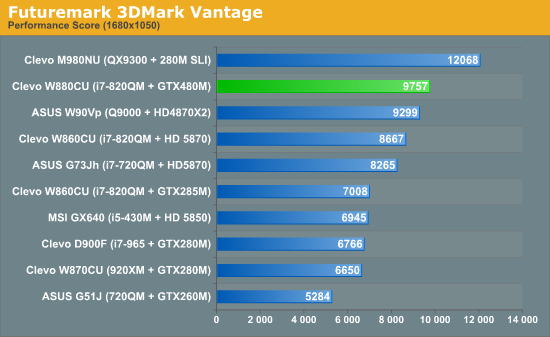
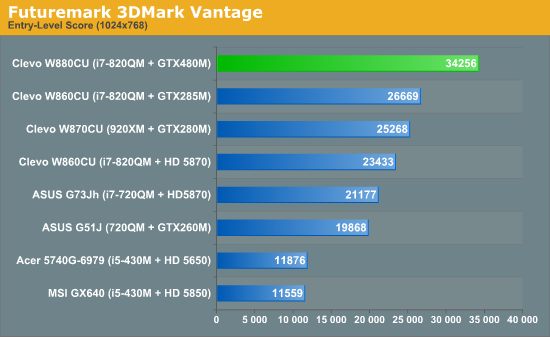

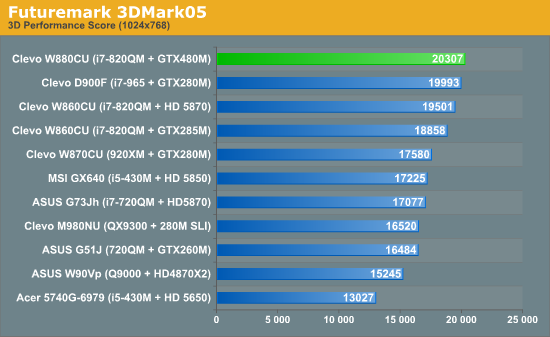
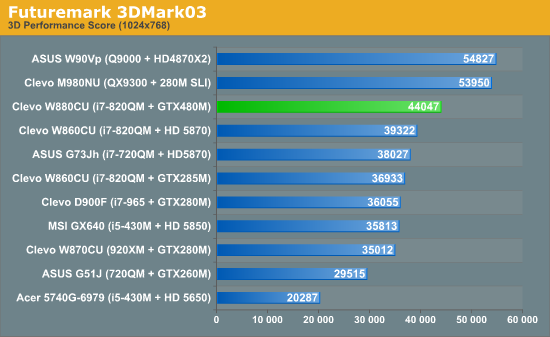
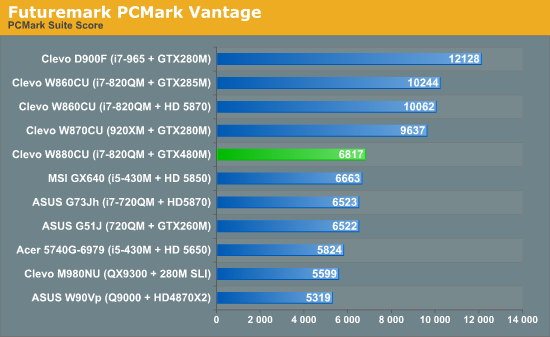
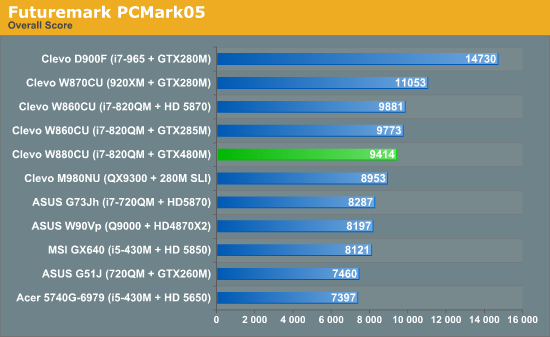
The first thing to notice is that the GeForce GTX 480M takes the W880CU to the top of the class in almost every 3DMark benchmark; in fact, the newer the 3DMark gets, the wider the 480M's lead. The only exceptions are units equipped with dual-GPU solutions. PCMark is much less favorable, but the reduced scores are very likely attributable to the SSDs used in the higher scoring test systems.
So how does the GeForce GTX 480M fare in actual gaming scenarios?










46 Comments
View All Comments
james.jwb - Thursday, July 8, 2010 - link
Forgot that I use magnification for this site. It's definitely the main cause of the huge performance hit, ouch! (dual-core, pretty fast machine really).I think it would be a lot easier if the space now used for the carousel became something static along the lines of Engadget's chunk for "top stories". It's nice to have something there to point out important reviews/news -- I wouldn't want to see the idea completely gone, it's just a carousel is so December 2009 :-)
Spoelie - Thursday, July 8, 2010 - link
While it seems generally true that power keeps increasing from generation to generation (3870, 4870, 5870), wasn't the big drop from the HD2900 series conveniently left out to make that statement stick?It's not really that power always increases, there's a ceiling which was reached a few generations ago and the only thing you can say is that the latest generations are generally closer to that ceiling than most of the ones before it. What the desktop GTX480 pulls is about the most what we will ever see in a desktop barring some serious cooling/housing/power redesigns.
bennyg - Thursday, July 8, 2010 - link
2900 was the P4 of the gfx card world regardings power/performance. It was only released because ATi had to have something, anything, in the marketplace. If ATi had as much cash in the bank as did Intel, they would have cancelled the 2900 like Intel did Larrabee.Thankfully the 2900 went on from its prematurity to underpin radeons 3, 4 and 5. Whereas Prescott was just brute force attempting to beat thermodynamics. Ask Tejas what won :)
JarredWalton - Thursday, July 8, 2010 - link
That's why I said "generally trending up". When the HD 2900 came out, I'm pretty sure most people had never even considered such a thing as a 1200W PSU. My system from that era has a very large for its time 700W PSU for example. The point of the paragraph is that while desktops have a lot of room for power expansion, there's a pretty set wall on notebooks right now. Not that I really want a 350W power brick.... :)7Enigma - Thursday, July 8, 2010 - link
Thank you for the article as many of us (from an interest standpoint and not necessarily from a buyer's standpoint) were waiting for the 480M in the wild.My major complaint with the article is that this is essentially a GPU review. Sure it's in a laptop since this is a notebook, but the only thing discussed here was the difference between GPU's.
With that being the case why is there no POWER CONSUMPTION numbers when gaming? It's been stated for almost every AVA laptop that these are glorified portable desktop computers with batteries that are essentially used only for moving from one outlet to the next.
I think the biggest potential pitfall for the new 480M is to see with performance only marginally better than the 5870 (disgusts me to even write that name due to the neutered design) is to see how much more power it is drawing from the wall during these gaming scenarios.
Going along with power usage would be fan noise, of which I see nothing mentioned in the review. Having that much more juice needed under load should surely make the fan noise increased compared to the 5870....right?
These are two very quick measurements that could be done to beef up the substance of an otherwise good review.
7Enigma - Friday, July 9, 2010 - link
Really no one else agrees? Guess it's just me then.....JarredWalton - Friday, July 9, 2010 - link
We're working to get Dustin a power meter. Noise testing requires a bit more hardware so probably not going to have that for the time being unfortunately. I brought this up with Anand, though, and when he gets his meter Dustin can respond (and/or update the article text).7Enigma - Monday, July 12, 2010 - link
Thanks Jarred!For all the other laptop types I don't think it matters but for these glorified UPS-systems it would be an important factor when purchasing.
Thanks again for taking the time to respond.
therealnickdanger - Thursday, July 8, 2010 - link
"Presently the 480M isn't supported in CS5; in fact the only NVIDIA hardware supported by the Mercury Playback Engine are the GeForce GTX 285 and several of NVIDIA's expensive workstation-class cards."I did the following with my 1GB 9800GT and it's an incredible boost. Multiple HD streams with effects without pausing.
http://forums.adobe.com/thread/632143
I figured out how to activate CUDA acceleration without a GTX 285 or Quadro... I'm pretty sure it should work with other 200 GPUs. Note that i'm using 2 monitors and there's a extra tweak to play with CUDA seamlessly with 2 monitors.
Here are the steps:
Step 1. Go to the Premiere CS5 installation folder.
Step 2. Find the file "GPUSniffer.exe" and run it in a command prompt (cmd.exe). You should see something like that:
----------------------------------------------------
Device: 00000000001D4208 has video RAM(MB): 896
Device: 00000000001D4208 has video RAM(MB): 896
Vendor string: NVIDIA Corporation
Renderer string: GeForce GTX 295/PCI/SSE2
Version string: 3.0.0
OpenGL version as determined by Extensionator...
OpenGL Version 2.0
Supports shaders!
Supports BGRA -> BGRA Shader
Supports VUYA Shader -> BGRA
Supports UYVY/YUYV ->BGRA Shader
Supports YUV 4:2:0 -> BGRA Shader
Testing for CUDA support...
Found 2 devices supporting CUDA.
CUDA Device # 0 properties -
CUDA device details:
Name: GeForce GTX 295 Compute capability: 1.3
Total Video Memory: 877MB
CUDA Device # 1 properties -
CUDA device details:
Name: GeForce GTX 295 Compute capability: 1.3
Total Video Memory: 877MB
CUDA Device # 0 not choosen because it did not match the named list of cards
Completed shader test!
Internal return value: 7
------------------------------------------------------------
If you look at the last line it says the CUDA device is not chosen because it's not in the named list of card. That's fine. Let's add it.
Step 3. Find the file: "cuda_supported_cards.txt" and edit it and add your card (take the name from the line: CUDA device details: Name: GeForce GTX 295 Compute capability: 1.3
So in my case the name to add is: GeForce GTX 295
Step 4. Save that file and we're almost ready.
Step 5. Go to your Nvidia Drivercontrol panel (im using the latest 197.45) under "Manage 3D Settings", Click "Add" and browse to your Premiere CS5 install directory and select the executable file: "Adobe Premiere Pro.exe"
Step 6. In the field "multi-display/mixed-GPU acceleration" switch from "multiple display performance mode" to "compatibilty performance mode"
Step 7. That's it. Boot Premiere and go to your project setting / general and activate CUDA
therealnickdanger - Thursday, July 8, 2010 - link
Sorry, I should have said for ANY CUDA card with 786MB RAM or more. It's quite remarkable.